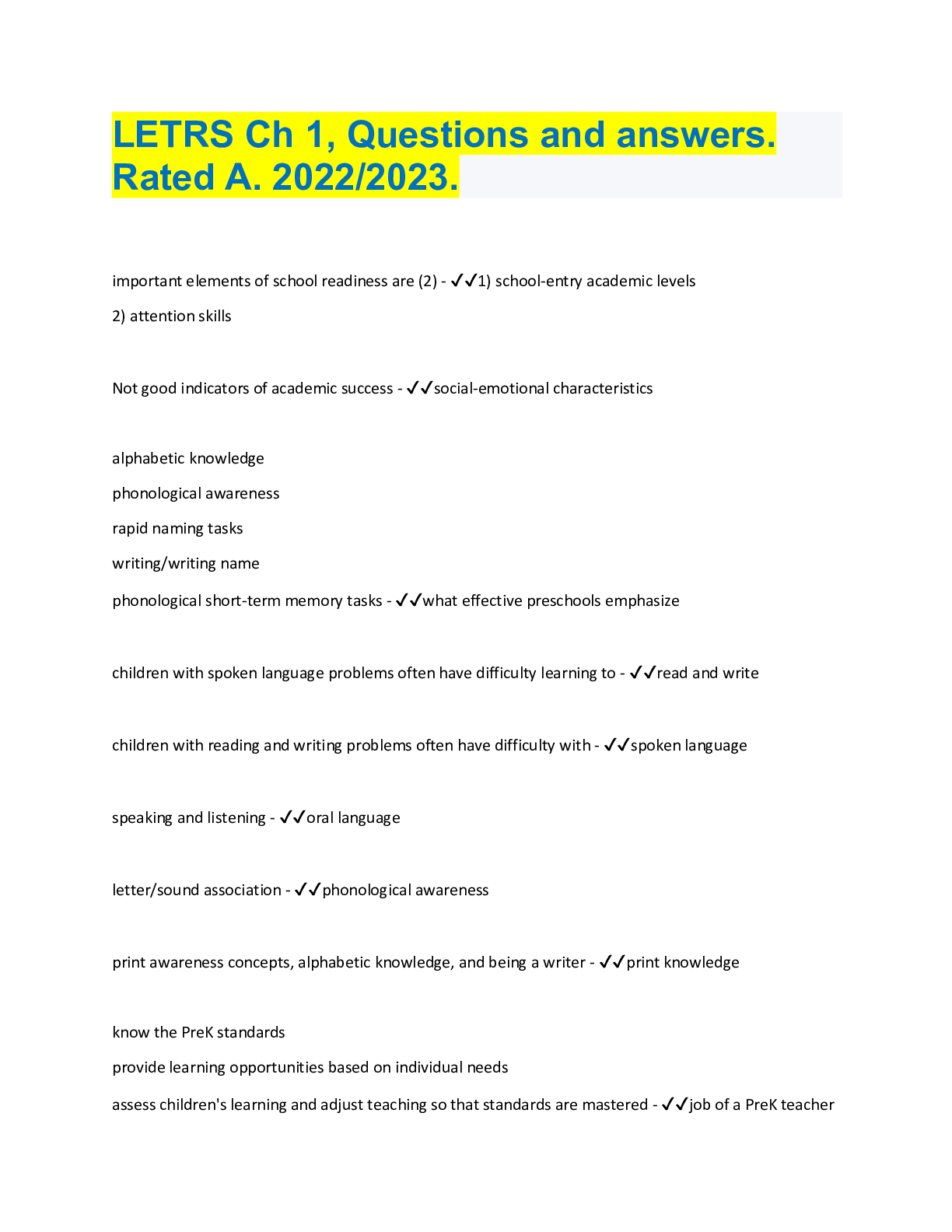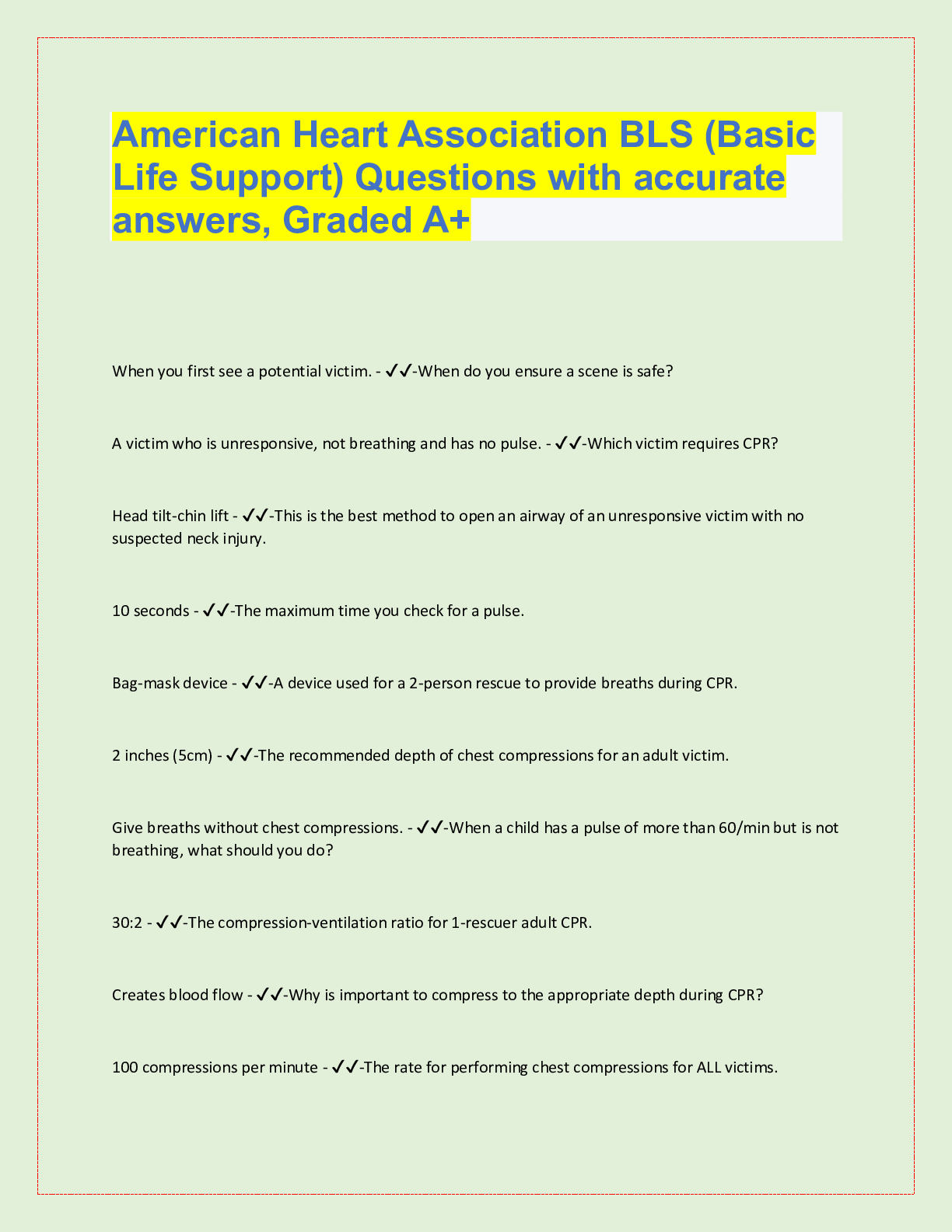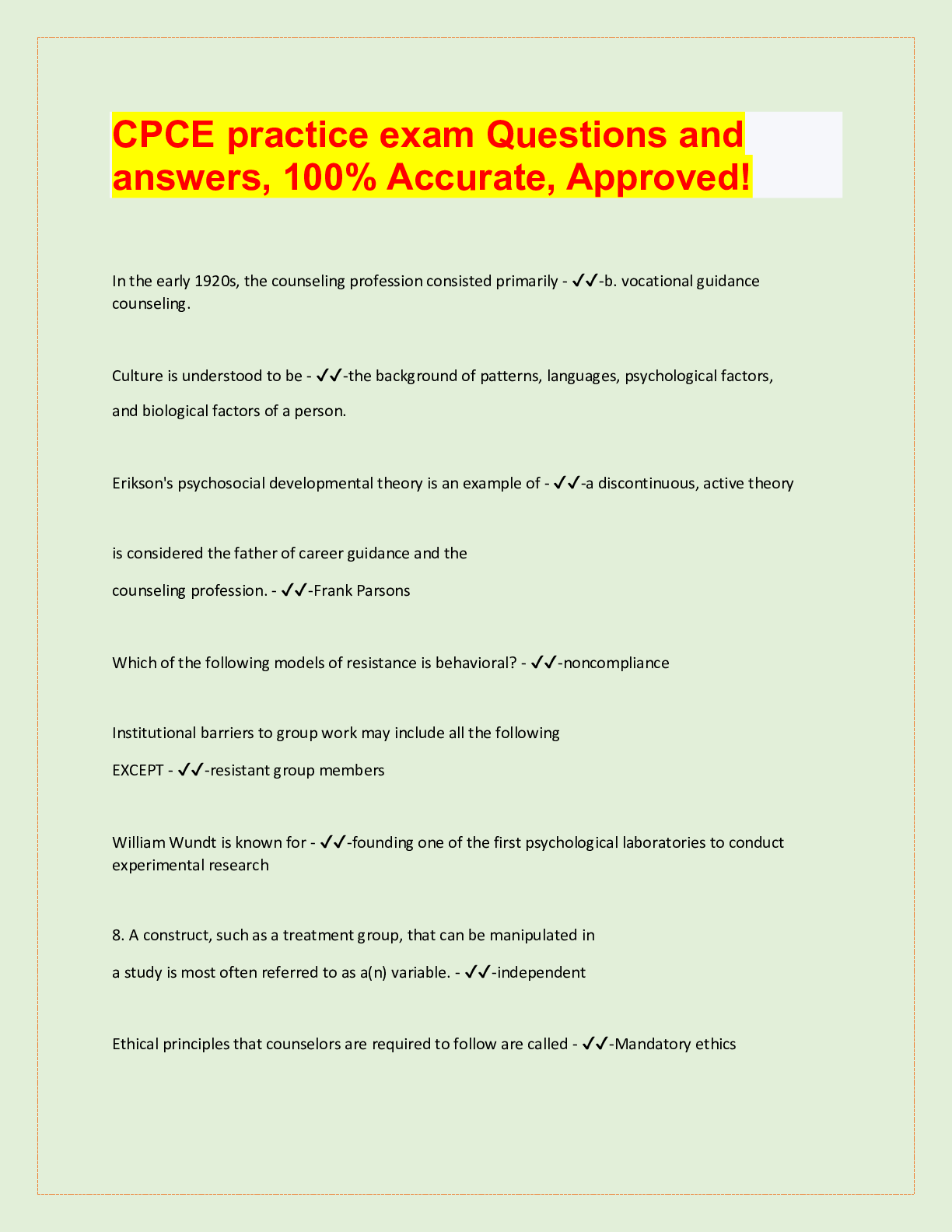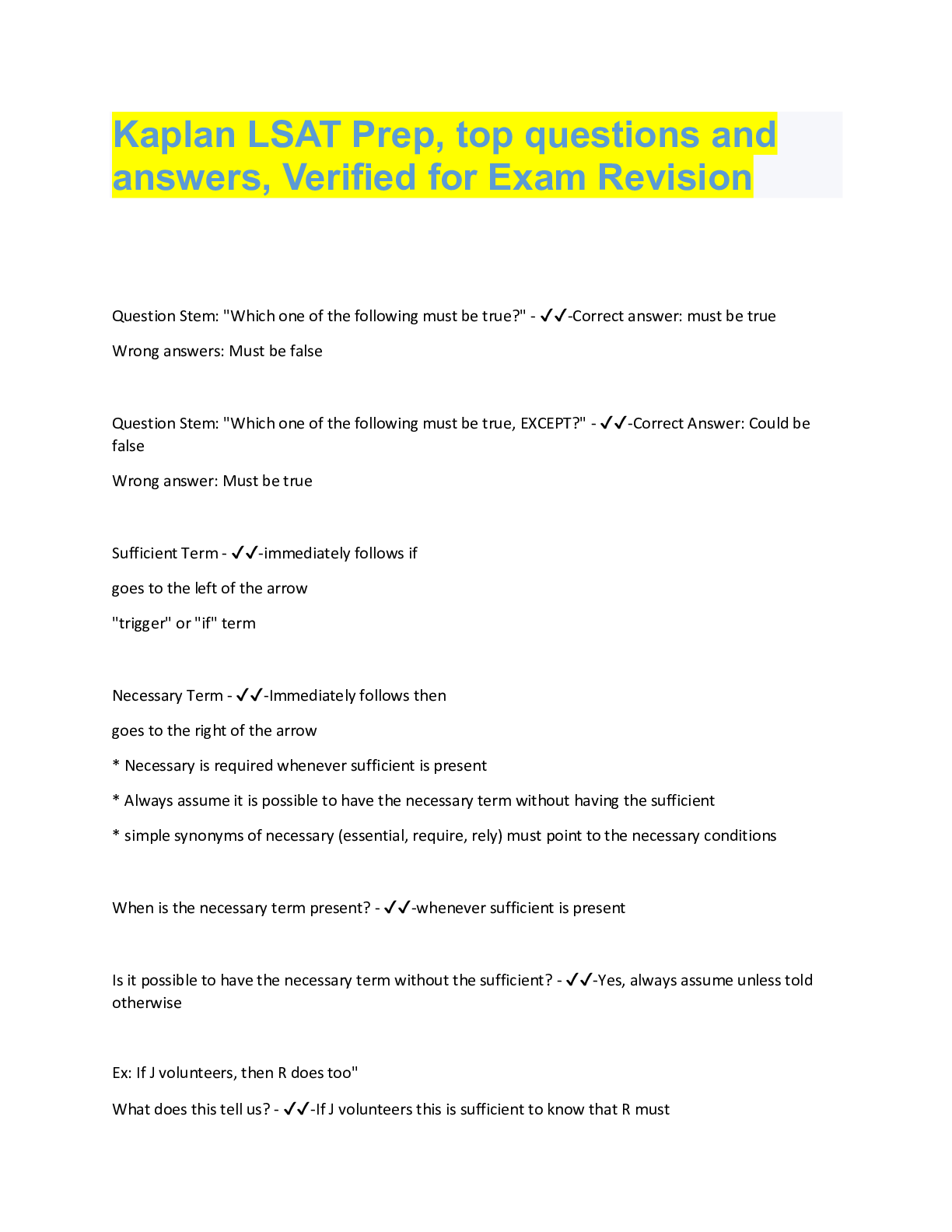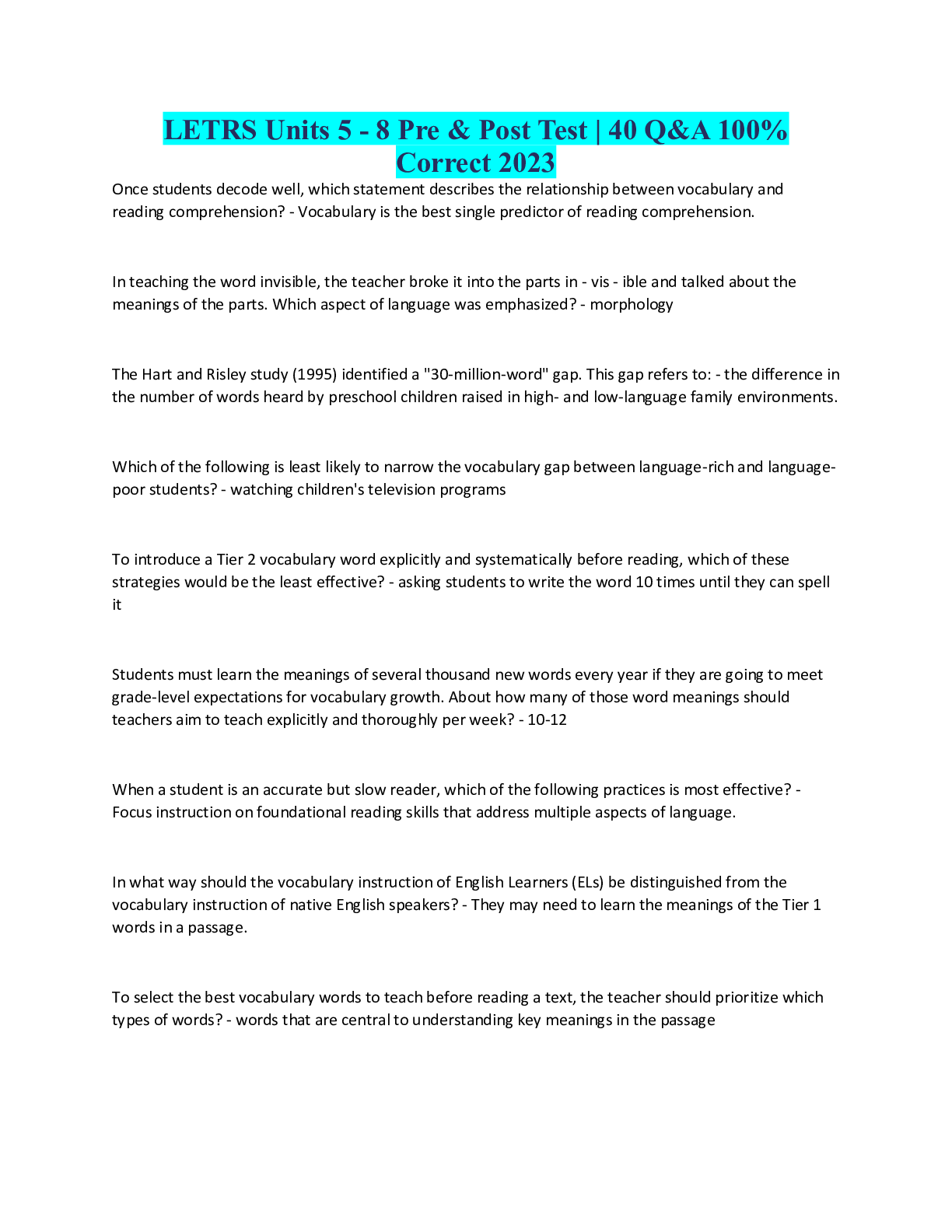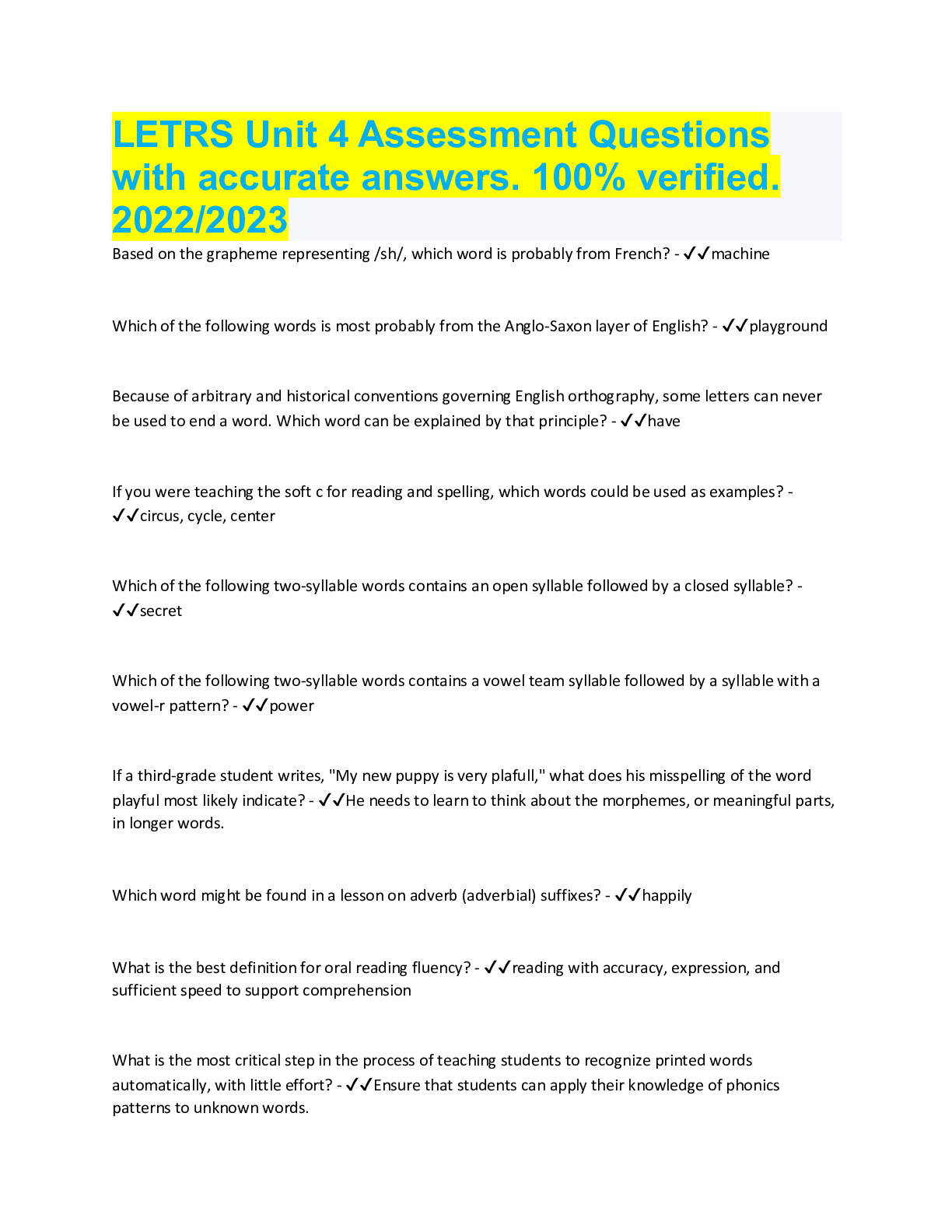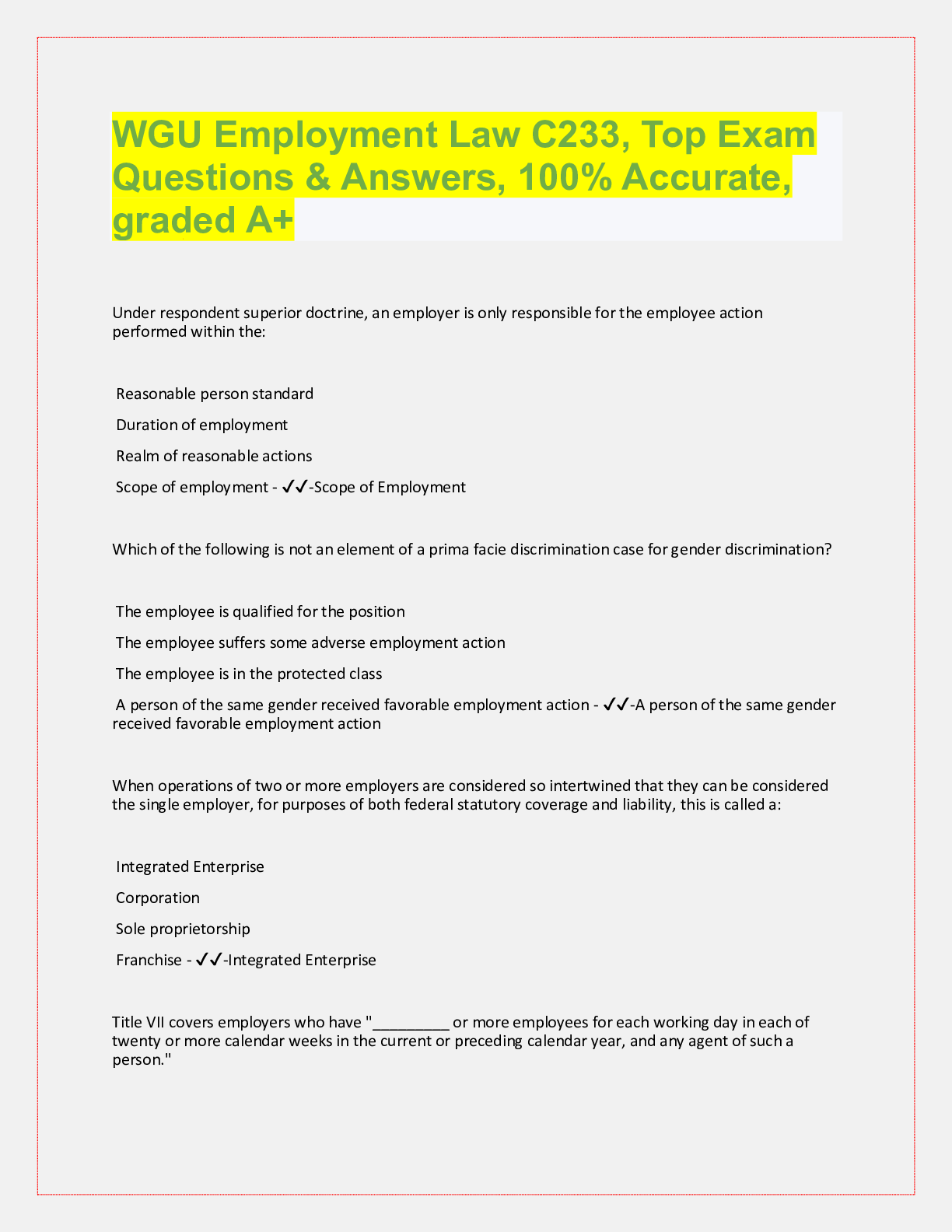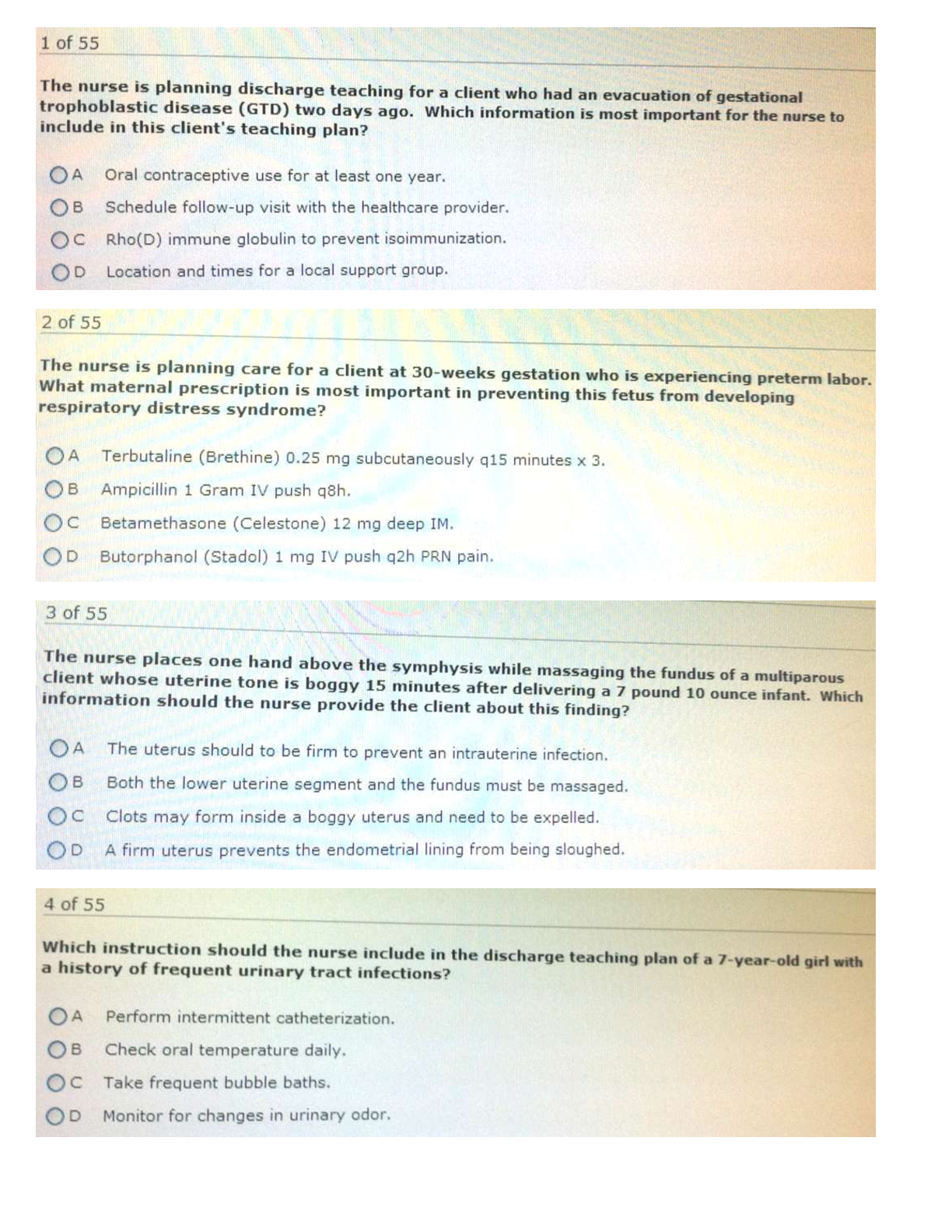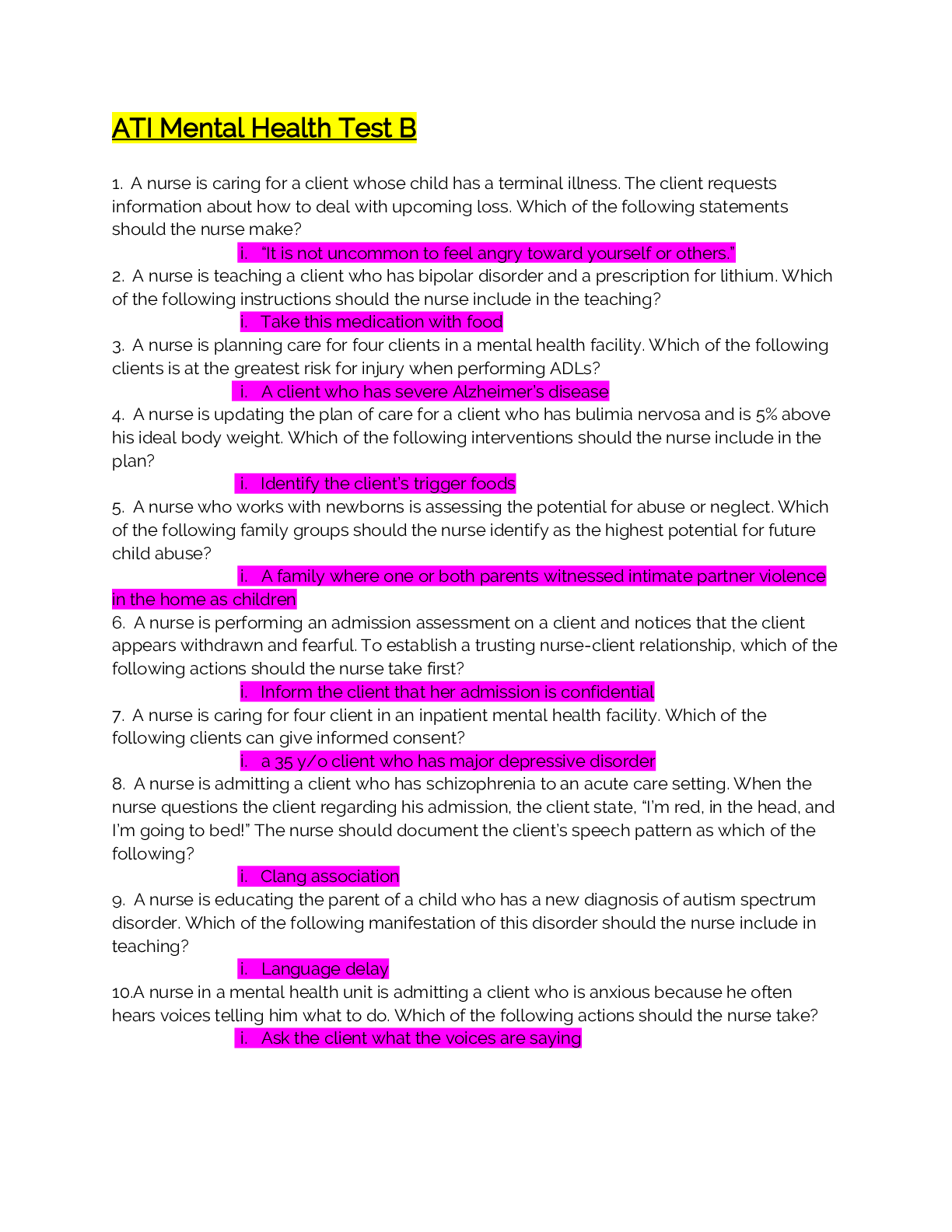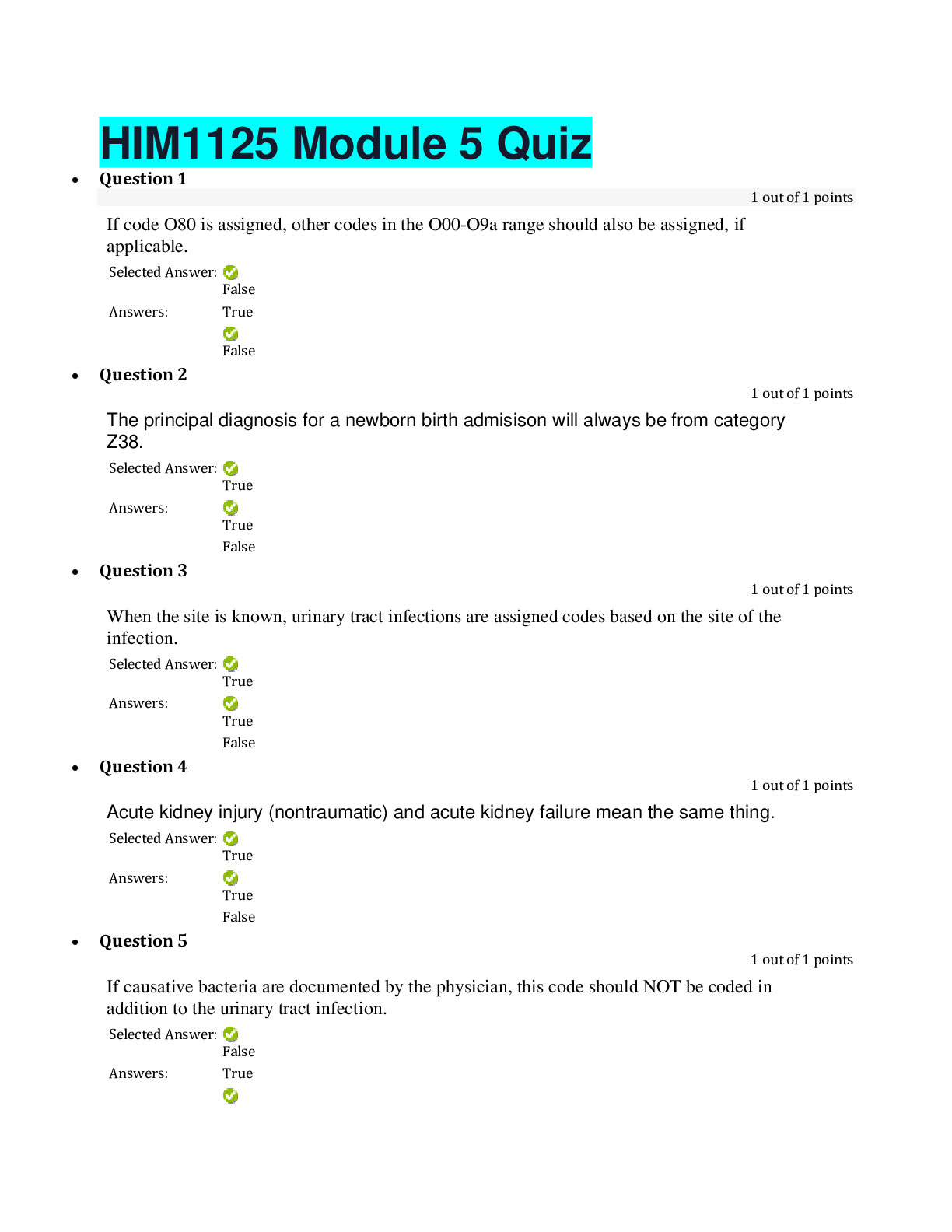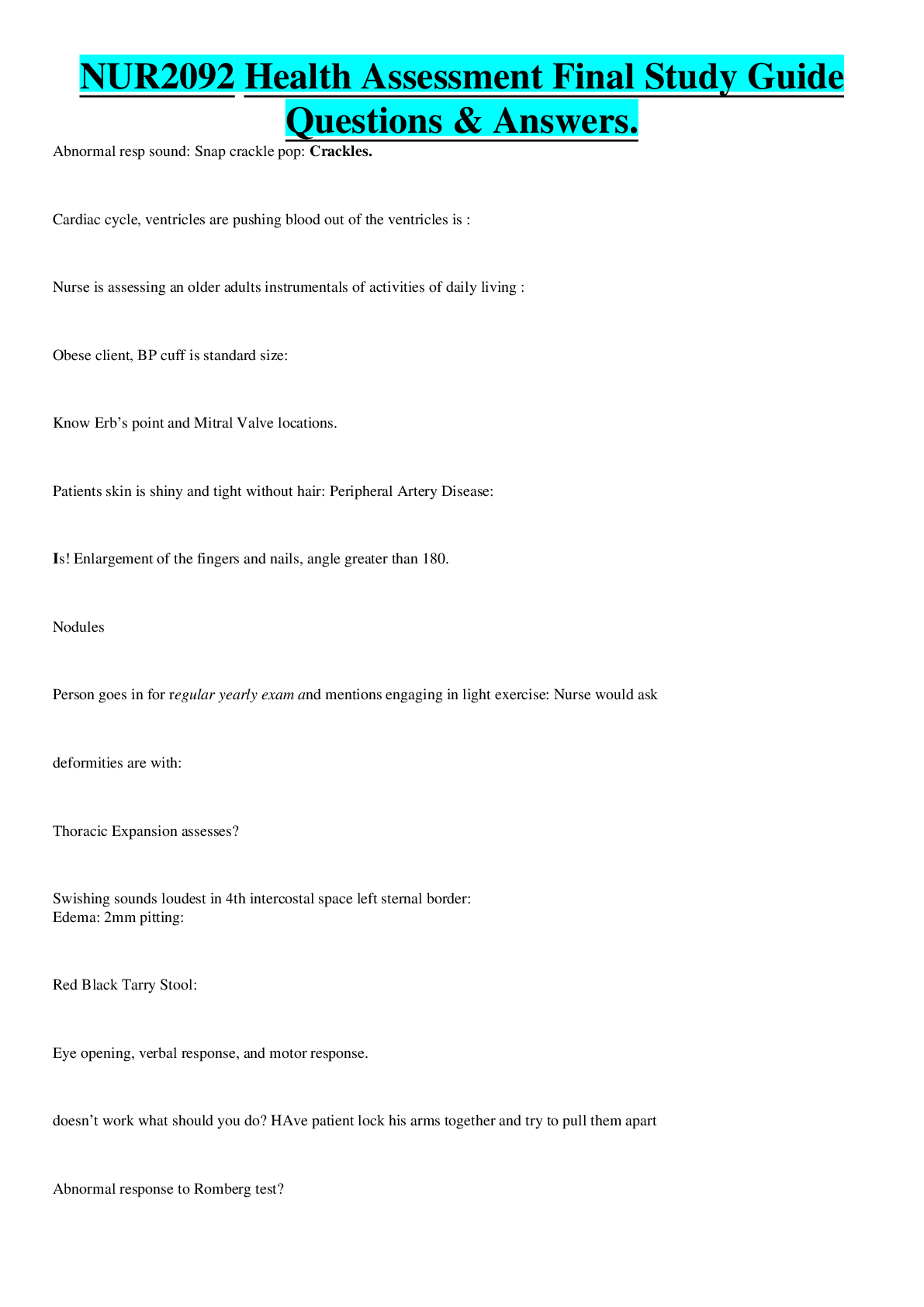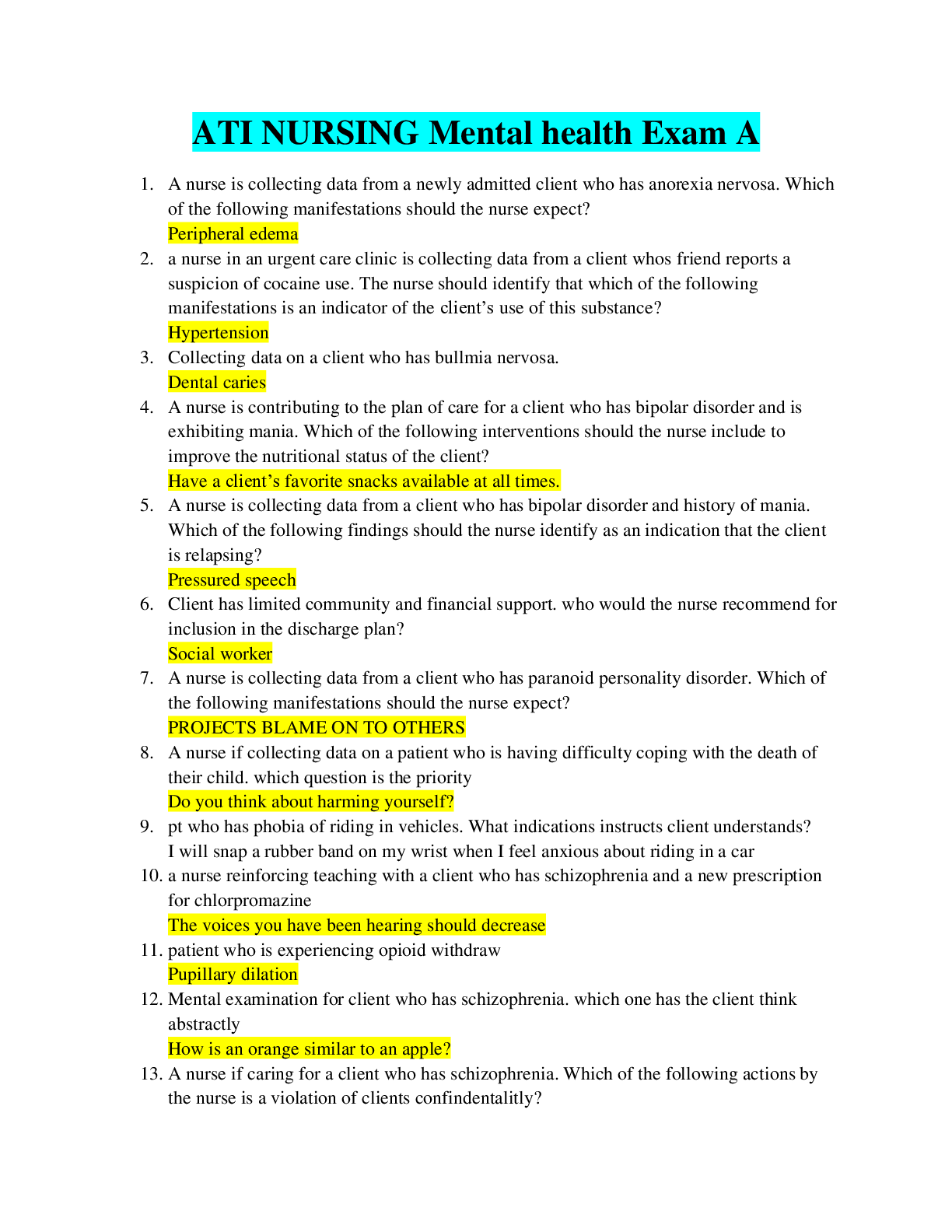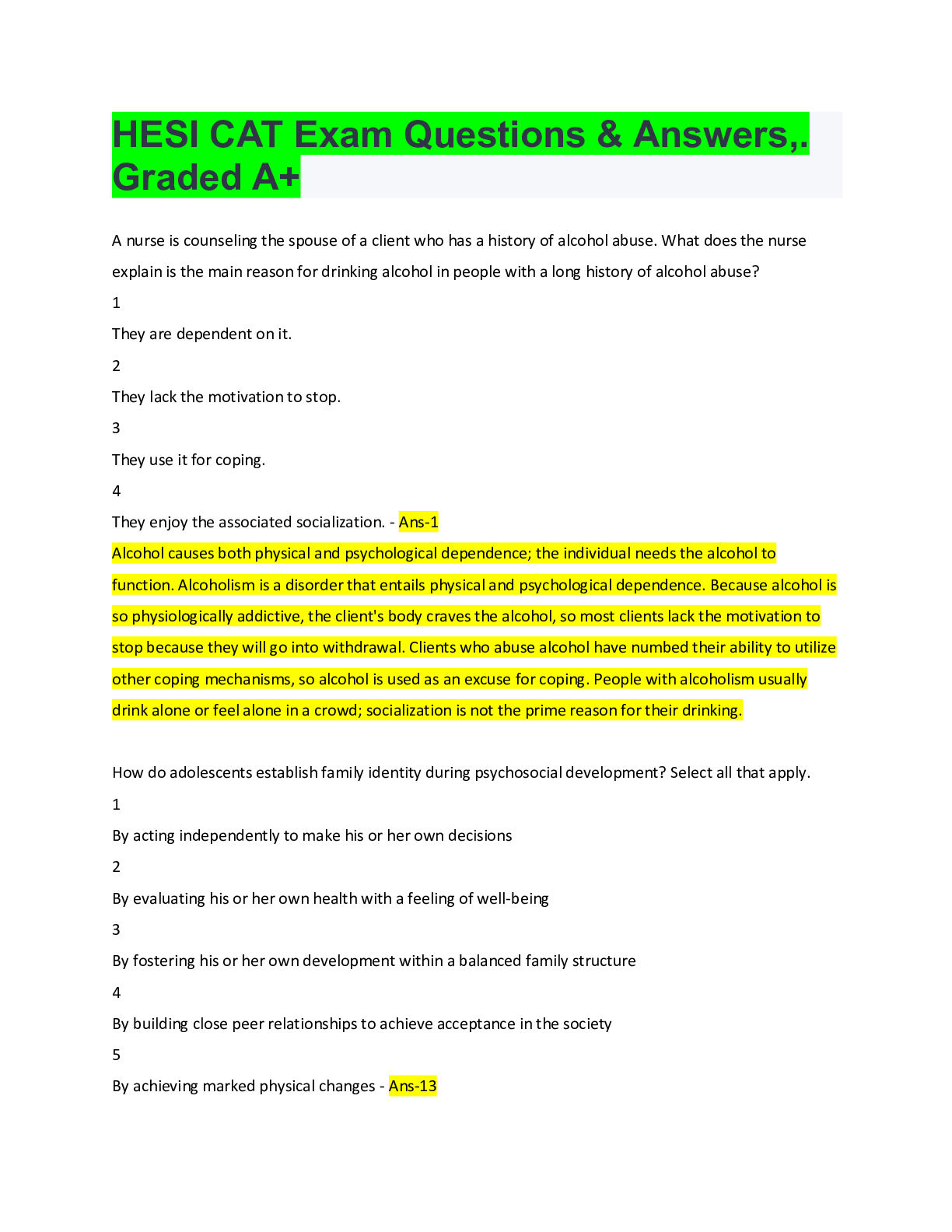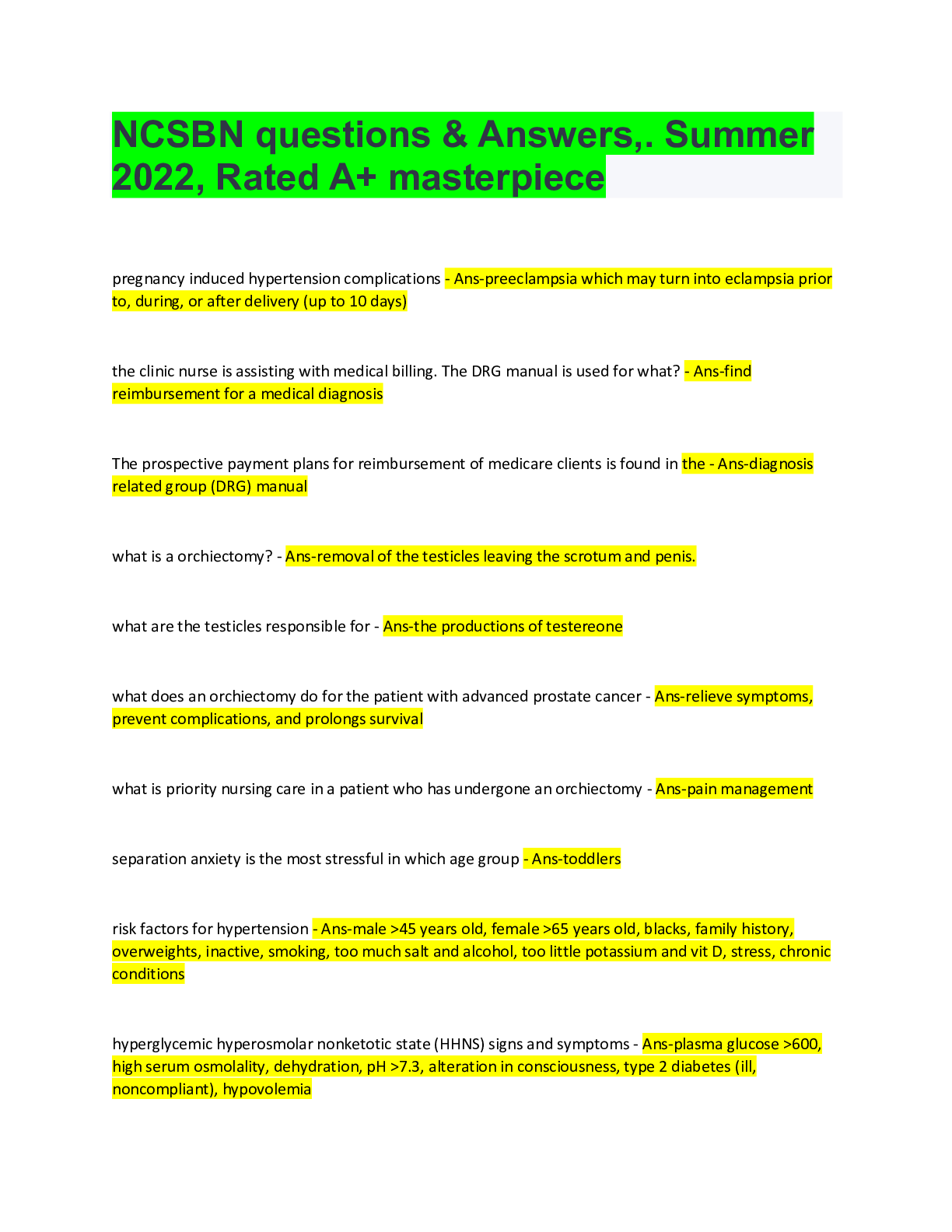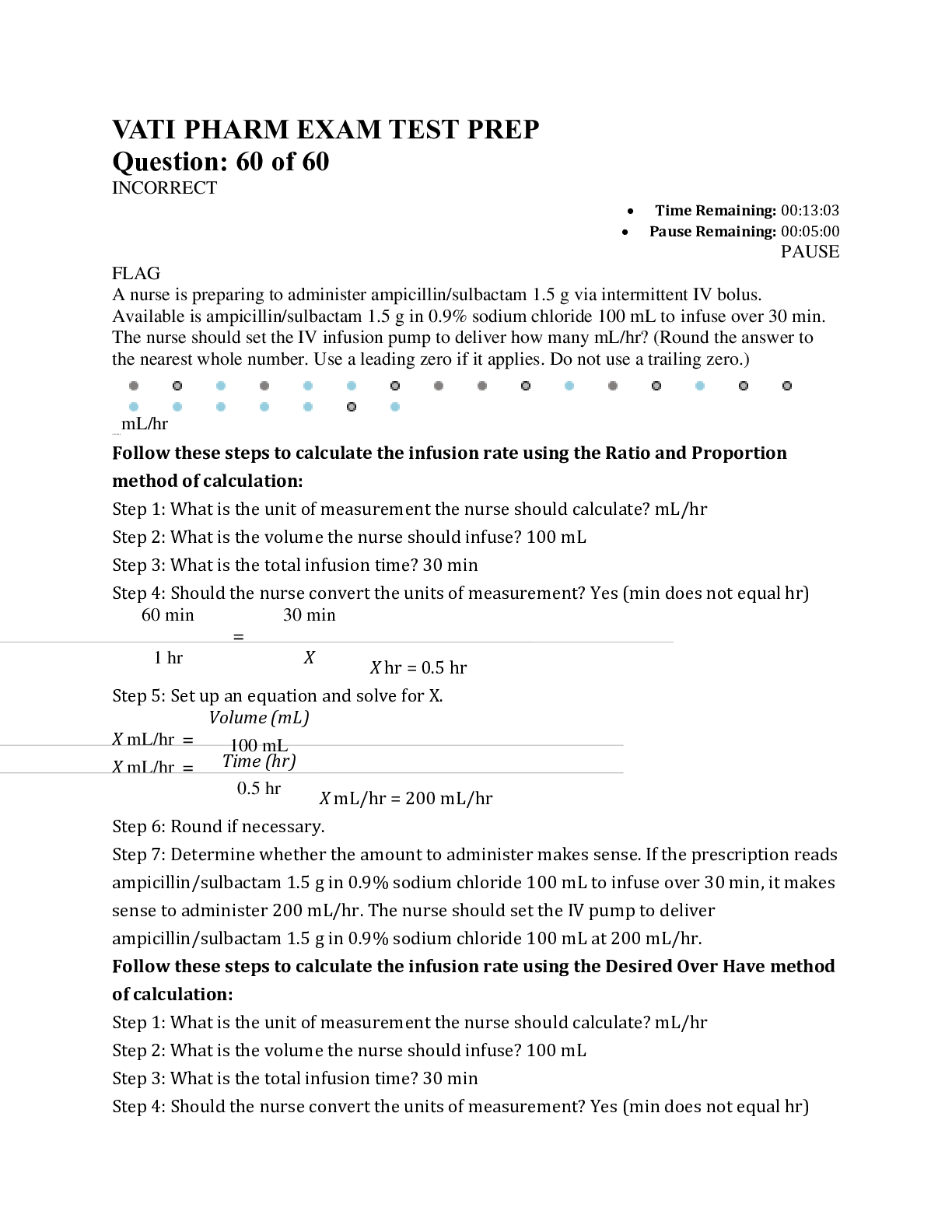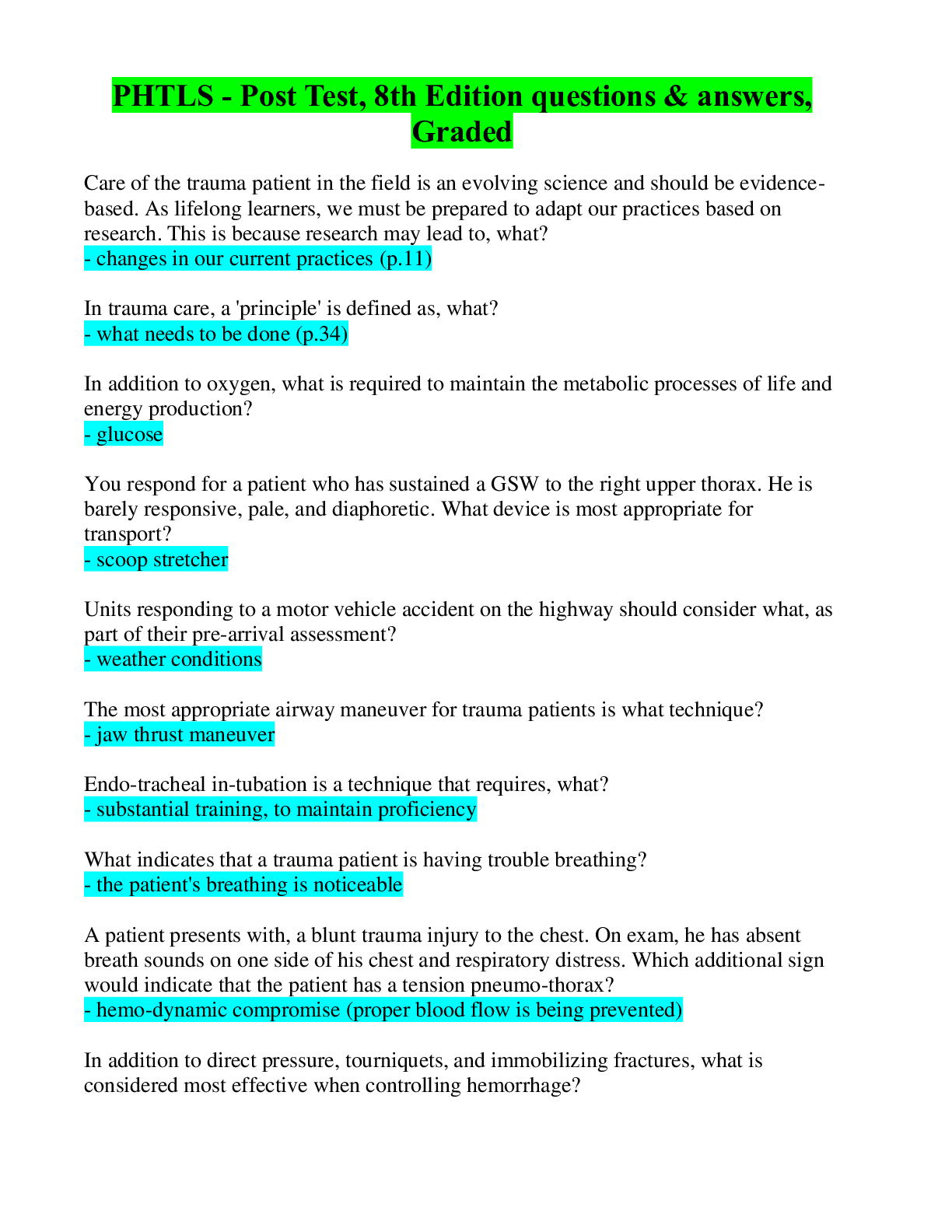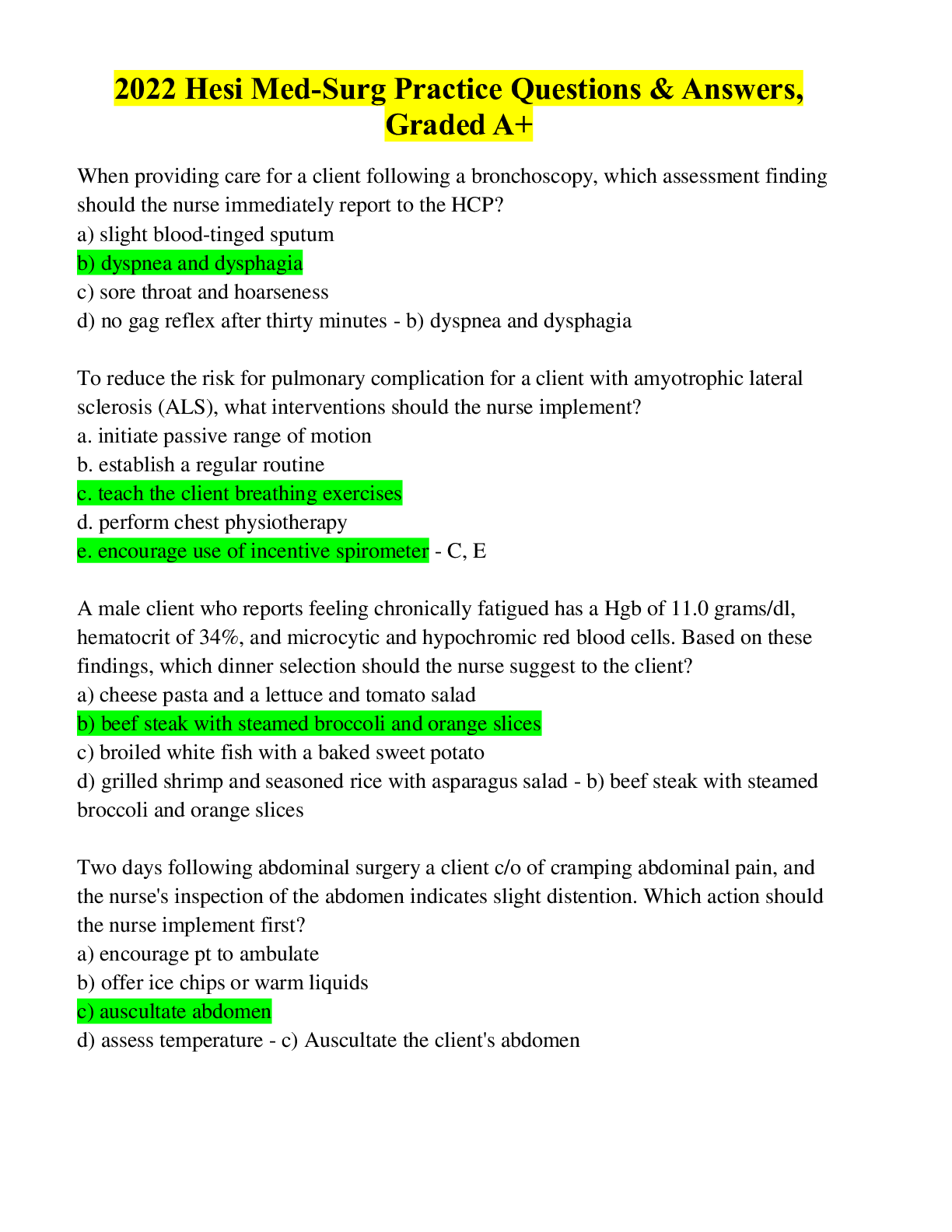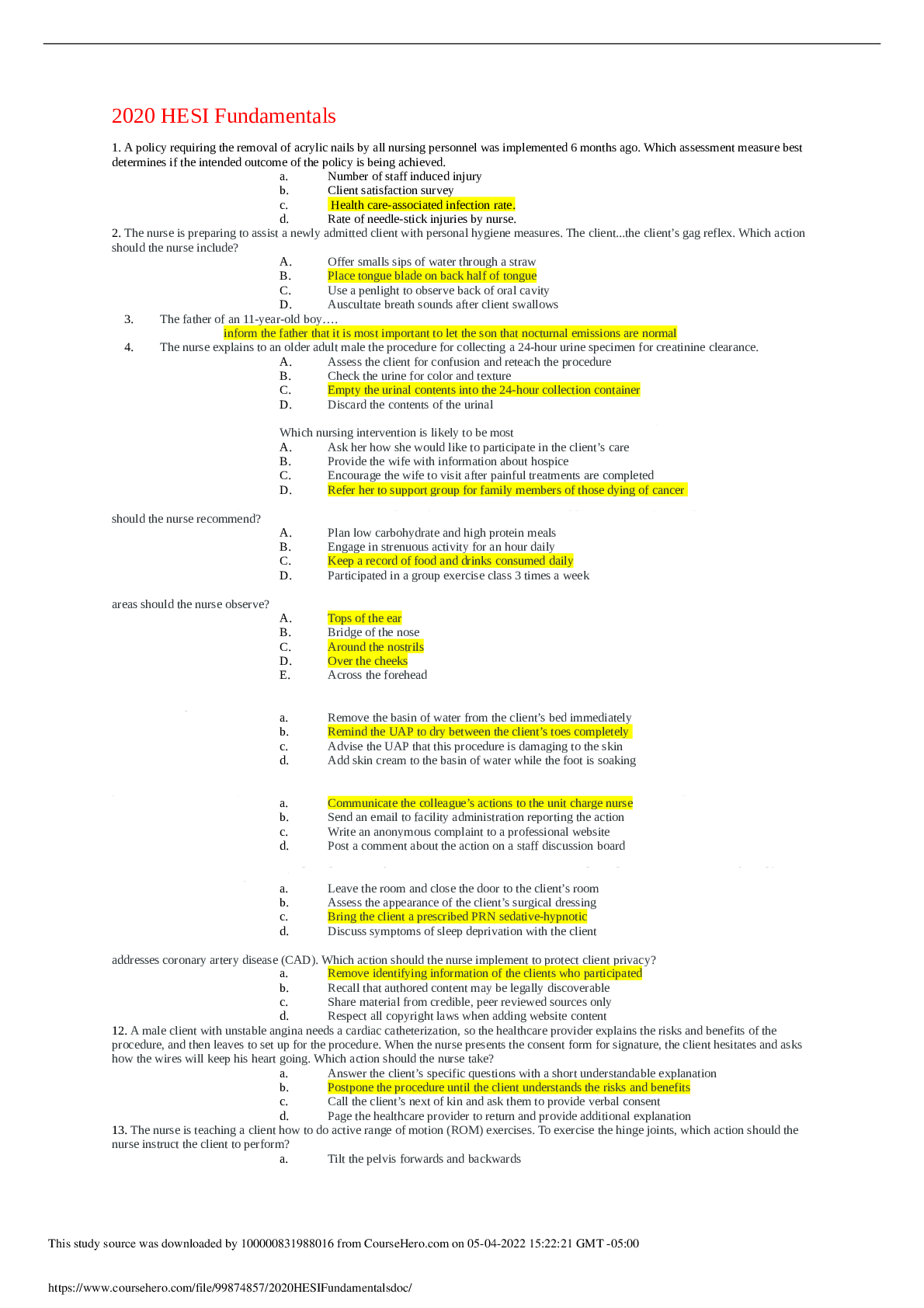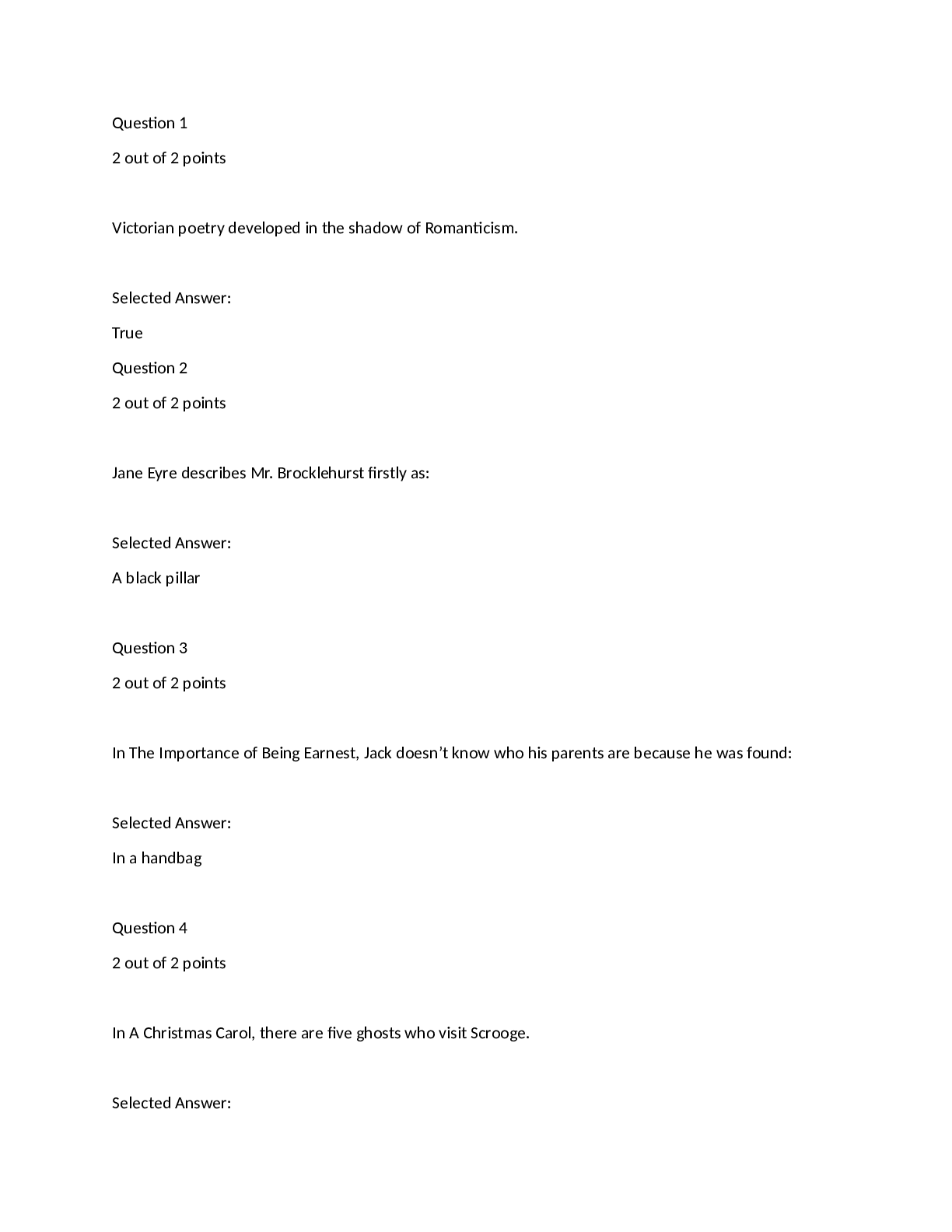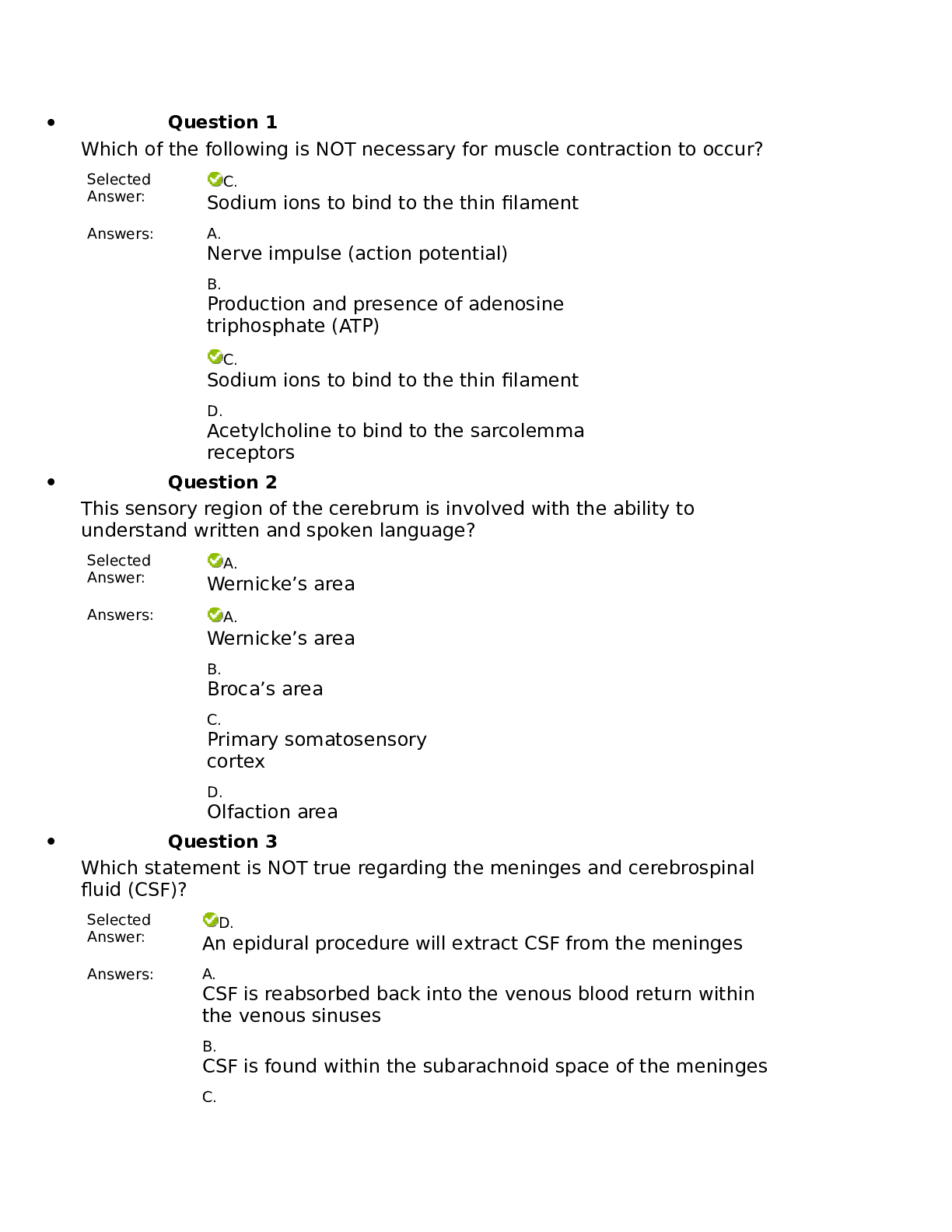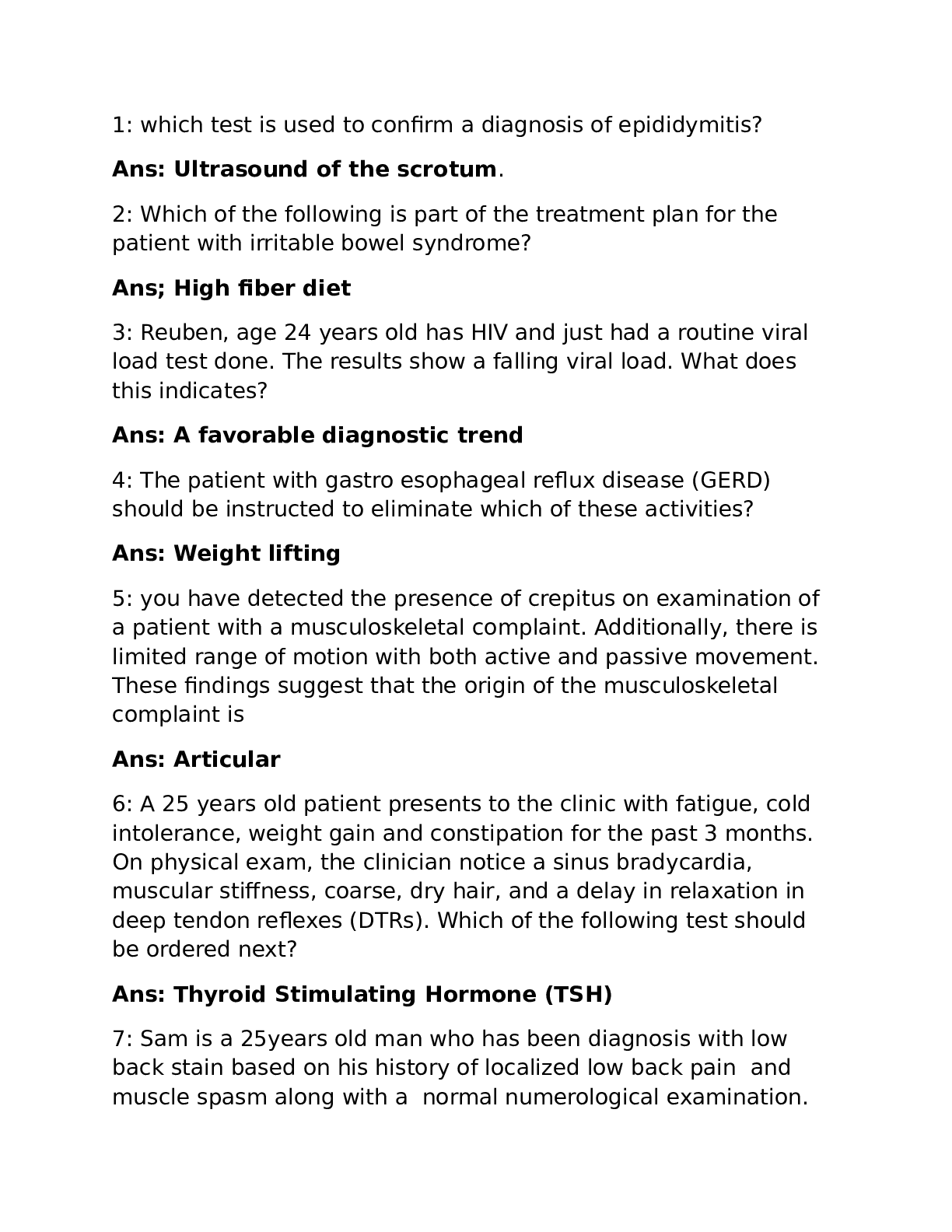*NURSING > QUESTIONS & ANSWERS > Ace Personal Trainer Exam 2021 Questions & Answers, graded A+ Most days of the week - ✔✔ch8 (All)
Ace Personal Trainer Exam 2021 Questions & Answers, graded A+ Most days of the week - ✔✔ch8
Document Content and Description Below
Ace Personal Trainer Exam 2021 Questions & Answers, graded A+ Most days of the week - ✔✔ch8 Current guidelines recommend physical activity performed how many days per week? Intensity - ✔✔c... h8 The most difficult variable of an exercise program to represent quantitatively is what? RPE Rating of Perceived Exertion - ✔✔ch8 What is a SUBJECTIVE method of measuring exercise intensity? Training Zone 1 - ✔✔ch8 If a client can talk comfortably during exercise they are in which training zone? In natural environments - ✔✔ch8 Green exercise refers to exercise conducted how/where? training zone 2 - ✔✔ch8 If the client is not sure they can talk comfortably, they are working in which training zone? training zone 3 - ✔✔ch8 If the client definitely cannot talk comfortably while training, they are working in which training zone? Duration - ✔✔ch8 What is probably the most appropriate variable to manipulate initially, building the exercise session by 10% every week or two over the first 4 to 6 weeks? Help clients have positive experiences with exercise - ✔✔ch8 During the Base Training phase of cardio respiratory exercise, what should be the primary emphasis for the personal Trainer? Increasing the time of exercise while introducing intervals - ✔✔ch8 The Fitness Training phase of cardiorespiratory training is focused on what? Dose related - ✔✔ch8 Benefits gained from physical activity are what related? ie greater benefits are derived from greater quantities of activity. every 60 to 120 min - ✔✔ch8 Breaks from sitting should take place after how long? Cardiovascular - ✔✔ch8 Training this system creates these adaptations heart muscle hypertrophy larger stroke volume some evidence suggests that the redistribution of cardiac output to active muscles may improve after training Muscular - ✔✔ch8 Training this system will produce these adaptations increased size and number of mitochondria growth in more capillaries around the recruited muscle fibers could also be adaptations to contractile mechanism increase in number of anaerobic enzymes may also be hypertrophy of the contractile proteins within the muscle fibers Respiratory - ✔✔ch8 Training in this system may produce these adaptations Both strength and fatigue resistance of these muscles improve with training. May lead to an increase in tidal volume making ventilation more efficient. Explain that the average adult muscle tissue loss of 5lb per decade and how resistance training can help her restore lost muscle and raise testing metabolism - ✔✔ch9 your new client is a 47 year old woman who wants to lose weight, but is a bit apprehensive about muscular training because she does not want to get big. Based on this information, what response would BEST facilitate muscular training program adherence and motivation? They contact more slowly and create lower force outputs. ie slow twitch fibers - ✔✔ch 9 Which of the following statements about the role of type 1 muscle fibers during muscular training exercises is MOST accurate? 2-3 sets of 12 or more repetitions. an endurance focused program which would be the most supportive of a client who wants to develop muscular endurance - ✔✔ch9 You are working with a new client who wants to begin muscular training in order to build muscular endurance. Which of the following set and repetition combinations would be BEST for helping them achieve that goal? Forward - ✔✔ch9 Anatomical position refers to a person standing erect with head, eyes, and palms facing how/ where? Sagital. Flexion describes movement in which the bones comprising a joint move toward each other in the Sagital plane decreasing the joint angle between them. - ✔✔ch9 Flexion occurs in what plane of motion? Flexion. Extension is the opposite of flexion and causes the angle between two adjoining bones to increase in the sagital plane - ✔✔ch9 Extension is the opposite joint action of? Contact. it helps develop tension - ✔✔ch9 One property that all muscle tissue has in common is its ability to? protect the public from harm by assessing if candidates meet established levels of minimum competence - ✔✔ch1 The primary purpose of professional certifications is to? assessing clients for exercise limitations to facilitate exercise program design - ✔✔ch1 which of the following is WITHIN the scope of practice for personal trainers? Creating an individualized nutritional program with specific meal plans based of physician recommendations - ✔✔ch1 which of the following is OUTSIDE the ACE Certified Personal Trainer scope of practice? while registering for an ACE certification exam - ✔✔ch1 At what point does a candidate for the ACE Personal Trainer Certification agree to uphold the ACE code of ethics? Stay current with the latest exercise science research and guidelines for fitness and health. - ✔✔ch1 The PRIMARY reason ACE has established a minimum continuing education requirement of 20 hrs every two years in order to maintain a certification is to help ACE Certified Personal Trainers what? helping clients gain a better understanding of portion sizes and healthful foods so they can make better choices - ✔✔ch1 Which of the following is WITHIN the ACE Certified Personal Trainer scope of practice? The personal Trainer becomes a licensed massage therapist - ✔✔ch1 A personal Trainer who wants to provide massage to help clients who have tight or sore muscles can do so ONLY if? They are accredited by National Commissions for Certifying Agencies - ✔✔ch1 What do most allied health certification programs, such as the credentials for registered dieticians, occupational therapist, and nurse practitioners, have in common with certifications from the American Council on Exercise? Unless the personal Trainer has other credentials such as an RD or MD, they do not possess the qualifications to legally recommend supplements - ✔✔ch1 which of the following is MOST accurate regarding personal trainers recommending supplements to their clients? Building nurturition plans - ✔✔ch1 Which of the following is NOT part of the knowledge, skills, and abilities assessed by the ACE Personal Trainer Cerification exam? Developing Rapport. - ✔✔ch2 Upon what foundational element is the ACE IFT Model built? Collecting health history data to identify limitations for exercise and the need for referral. - ✔✔ch2 What assessments are essential according to the ACE IFT Model and should be completed prior to a client beginning an exercise program? Conducting initial comprehensive assessments of fitness and body composition - ✔✔ch2 Which of the following is MOST likely to create a barrier to fitness related behavioral change for some clients? Bend and lift, single leg, pushing, pulling, and rotational movements - ✔✔ch 2 What 5 primary movements are the focus of the Movement Training phase? Functional Training Focus is on establishing or in many cases reestablishing, postural stability and kinetic chain mobility through the introduction of exercise programs that improve joint function through improved muscular endurance, flexibility, core function, static balance and dynamic balance - ✔✔ch 2 In what phase of the Muscular Training component of the ACE IFT Model would a person be categorized if they have lumbar lordosis and limited range of motion in the hips and shoulders? To help the personal Trainer observe a client's efficacies in postural stabilization, balance, and core function. - ✔✔ch10 Describe the purpose of functional assessments in the ACE IFT Model of Function Movement and load and Speed. The right angle rule describes how the body represents itself in vertical alignment across the major joints. the ankle, knee, hip, shoulder, and spine. applying the right angle for allows the personal Trainer to observe postural deviations in all 3 planes noting specific static assymmetries at the joints (front to back, left and right) - ✔✔ch10 Describe the right angle rule of the body. The body is rarely perfectly symmetrical , so overanalizing asymmitries is time consuming. potentially intimidating to clients and may induce muscle fatigue in the client that can alter their posture even further. - ✔✔ch10 Explain why PTs should focus on obvious, gross imbalances and avoid getting caught up in minor postural asymmetries. Hypflexors - ✔✔ch10 Anterior tilting of the pelvis frequently occurs in individuals with tight ? Lordosis - ✔✔ch10 An anterior pelvic tilt will increase ____?______ in the lumbar spine. Shoulders not level Asymmetry to midline Protracted Medically rotated humerous Kyphosis and depressed chest - ✔✔ch10 List 3 deviations of the thoracic spine and shoulders. Correctible factors - repetitive movements(muscular pattern overload) awkward positions and movements ( habitual poor posture) side dominance, lack of joint stability, lack of joint mobility and an imbalanced strength training program Non-corectible - include congenital conditions, like scoliosis, some pathologies, like rheumatoid arthritis, structural deviations and certain types of trauma, like surgery, injury or amputation. - ✔✔ch10 Muscle imbalances and postural deviations can be attributed to many factors(correctable and non correctible). Describe these factors as if you were explaining them to a client. Tightness in the upper trapezius, levator scapulae and rhomboids. - ✔✔ch10 If it is observed that a client's shoulders are not level, it might indicate ___________? Tightness in the pectoral major, latissimus dorsi and subscapularis muscles. The upper fibers of the trapezius are angled upward and obliquely and have a primary function of elevating the scapula. - ✔✔ch10 If a PT observes that a client has a medially rotated humerus, it might indicate __________? Cervical Extensors With good posture, the earlobe should align approximately over the acromion process in the sagittal view, but given the many awkward postures and repetitive motions of daily life a forward head position is very common - ✔✔ch10 What muscles would you suspect are tight in a client with a forward head position? Unipedal stance test The unipedal stance test (also sometimes referred to as the timed one leg stance test) provides persona trainers with a simple yet valid and reliable option to test the static balance of their clients - ✔✔ch10 The __________ can be used to test a clients static balance. Y balance test The Y balance test can be used to assess dynamic balance. the Y balance test requires clients to balance on one leg and concurrently reach as far as possible with the other leg in three directions: anterior, posteromedial and posterolateral. Asymmetries between legs during the Y balance test are related to injury risk and may indicate the need for guided injury prevention strategies. - ✔✔ch10 To asess dynamic balance, personal trainers can use the ____________. 3 The Y balance test requires clients stand on one leg and reach in three directions. anterior, posteromedial, and posterolateral. ther naming of the three reaches is based on the directional terms of the stance foot (anterior, posterior and lateral) - ✔✔ch10 The Y balance test is performed in ______ directions. 1.0 McGill suggest that the flexion extension ratio should be less than 1.0. For example, a flexion score of 120 seconds and extension score of 150 seconds generates a ratio score of 0.80. - ✔✔ch10 McGill suggest that a ratio between flexion and extension should be less than _________ to indicate balanced endurance among the muscle groups. Hip flexor length The objective of the Thomas test is to evaluate the length of the muscles involved in hip flexion (ie hip flexors and rectus femoris). This test assesses the length of the primary hip flexors. - ✔✔ch10 The Thomas test is used to assess ____________. A lack of core and gluteal strength Lumbar dominance implies a lack of core and gluteal muscle strength to counteract the force of the hip flexors and erector spinae as they pull the pelvis forward during a squat movement. - ✔✔ch10 If a client exhibits lumbar dominance in the squat movement, this indicates __________. Lower extremity muscular endurance This assessment evaluates muscular endurance of the lower extremity when performing repititions of a squat to stand movement. This assessment is only suitable for individuals who demonstrate proper form when performing a squat. It can be used to effectively gauge relative improvements in a clients lower extremity muscular endurance. - ✔✔ch10 The body weight squat assessment evaluates __________. Movement training focuses on establishing efficient movement through Healthy ROMs specific to each client, essentially teaching clients to perform the five primary movements effectively in all three planes of motion without compromising postural or joint stability - ✔✔ch10 Describe the purpose of Movement assessments in the ACE IFT Model of Function, Movement, and load and Speed. Bend and lift Single Leg Pushing Pulling Rotation - ✔✔ch10 What are the five primary movements as assessed in the movement phase? This training phase emphasizes muscular endurance and strength, and/or improved skill performance in activities that rely on power, speed, agility, and quickness. - ✔✔ch10 Describe the purpose of Load and Speed assessments in the ACE IFT Model of Function, Movement, and load and Speed. 1. Formulating a question 2. Searching for Health and fitness research evidence that best answers the formulated question 3. scrutinizing the quality of the research evidence 4. Incorporating the research evidence into exercise program design and implementation 5. Evaluating exercise program outcomes and periodically reevaluating the research evidence. Keeping Current! - ✔✔ch11 Describe the five steps of evidence based practice. 1. Establish Rapport and identify cllient goals 2. Administer an exercise preparticipation health screening 3. Identify barriers and collaborate on next steps 4. Determine if physiological or movement assessments are necessary 5. Determine in which phase of the ACE IFT model to begin 6. prioritize program design and select exercise order - ✔✔ch11 List the six steps for client centered exercise programming. The exercise programming in the Base Training phase is intended to help people move more consistently to establish basic cardiorespiratory endurance. This in turn will lead to improved overall health, energy, and mood and increased caloric expenditure. Encouragement and exercise activities that can be successfully completed in each workout are crucial for building client self efficacy in this phase - ✔✔Describe the purpose of Base Training. Increased resting heart rate disturbed sleep decreased hunger on multiple days - ✔✔ch11 List 3 signs of the overtraining syndrome. Talk Test - ✔✔ch11 The easiest method for monitoring intensity with clients during Base Training is to use the _______. The first Ventilatory threshold (VT1) - ✔✔ch11 If a client can perform the exercise and talk comfortably, they are likely exercising below_________. Reciprocal inhibition is the principle stating that activation of a muscle on one side of a joint(ie the agonist) coincides with neural inhibition of the opposing muscle on the other side of the joint(ie the Antagonist) to facilitate movement. - ✔✔ch11 Describe the principle of reciprocal inhibition. Self myofascial release is a technique that applies pressure to tight restricted areas of fascia and underlying muscle in an attempt to relieve tension and improve flexibility. It is thought that applying direct sustained pressure to a tight area can inhibit the tension to a muscle. Tightness in soft tissure may be diminished through the application of pressure(eg self myofascial release) followed by static stretching. - ✔✔ch11 Describe self myofascial release Base Training Focus on moderate intensity cardiorespiratory exercise (RPE=3to4) while keeping an emphasis on enjoyment keep intensities below the talk test threshold (below VT1) Increase duration and frequency of exercise bouts Progress to Fitness Training when the client can complete at least 20 min of cardiorespiratory exercise below the talk test threshold at least 3 times per week. - ✔✔ch11 Summarize the Base Training Phase of Cardiorespiratory Training Fitness Training Progresses cardiorespiratory exercise duration and frequency based on the clients goals and available time Integrate vigorous intensity (RPE=5to6)cardiorespiratory exercise intervals with segments performed at intensities below at and above VT1 to just below VT2 - ✔✔ch11 Summarize the Fitness Training Phase of Cardiorespiratory Training Performance Training Progresses moderate and vigorous intensity cardiorespiratory exercise. Program sufficient volume for the client to achieve goals. Integrate near maximal and maximal intensity(RPE=7to10) intervals performed at and above VT2 to increase aerobic capacity, speed and performance Periodized training plans can be used to incorporate adequate training time below VT1, from VT1 to just below VT2 and at or above VT2. - ✔✔ch11 Summarize the Performance Training phase of Cardiorespiratory Training. Functional Training Focus on establishing /reestablishing postural stability and kinetic chain mobility. Exercise programs should improve muscular endurance, flexibility, core function, and static and dynamic balance progress exercise volume and challenge as function improves. - ✔✔ch11 Summarize the Functional Training Phase of the Muscular Training Model Movement Training Focus on developing good movement patterns without compromising postural or joint stability Programs should include exercise for all five primary movement patterns in varied planes of motion Integrate Functional Training exercises to help clients maintain and improve postural stability and kinetic chain mobility - ✔✔ch11 Summarize the Movement Training Phase of the Muscular Training Model Load/Speed Training Focus on application of external loads to movements to create increased force production to meet desired goals Integrate the five primary movement patterns through exercises that load them in different planes of motion and combinations Integrate Functional Training exercises to enhance postural stability and kinetic chain mobility to support increased workloads Programs should focus on adequate resistance training loads to help clients reach muscular strength, endurance and hypertrophy goals Clients with goals for athletic performance will integrate exercises and drills to build speed, agility, quickness, and power - ✔✔Ch11 Summarize the Load/Speed Training Phase of the Muscular Training Model Proprioceptive Neuromuscular Facilitation - ✔✔ch11 What type of flexibility is being described? _______________ Originally developed and used to treat increased tissue tonicity in the rehabilitation setting , this technique capitalizes on the principles of autogenic inhibition and reciprocal inhibition. there are 3 basic techniques used: hold relax, contract relax. and hold relax with agonist contraction. Static Stretching - ✔✔Ch11 What Type of flexibility is being described? _________________ This technique places the targeted muscle group in an end range position and is held for up to 30 seconds. This technique does not require a partner and it does not elicit the stretch reflex, reducing the likelihood of injury. As long as the stretch is not too intense(does not provoke pain) there are no real disadvantages to this technique. Ballistic Stretching - ✔✔ch11 What type of flexibility is being described? ______________ This technique is commonly used in athletic drills and in pertaining warm ups. The bouncing movements trigger the stretch reflex and thus may be associated with an increased risk for injury Dynamic Stretching - ✔✔ch11 What type of flexibility is being described? ________________ This technique mimics movement patterns to be used in the upcoming workout or sporting event. It is commonly used to help athletes prepare for competition by allowing them to increase sport specific flexibility. Linear Forward Lateral Backpedal Rotational Crossover Cutting Curving - ✔✔ch11 List the movement pattern progressions for plyometric exercises. At least 2-3 days a week with daily participation being most effective - ✔✔ch11 The evidence based recommendation for frequency of flexibility exercises is ___________. Base Training The exercise programming in the Base Training Phase is intended to help people move more consistently to establish basic cardiorespiratory endurance. - ✔✔ch11 Any Client who is not consistently performing moderate intensity cardiorespiratory exercise should begin with ______________ 20 Once the client is comfortable with assessments and can sustain steady state cardio exercise for 20 min in zone 1 (RPE 3to4) they can move from Base To Fitness Training. - ✔✔ch11 Once a client can sustain stready state cardiorespiratory exercise for __________ minutes in zone 1, they can move on to Fitness Training 80-100 contacts per session Volume in plyometric training is expressed as the number of repetitions and sets performed in a given workout. For lower body plyometric training, repetitions are counted as the number of foot contacts per session. - ✔✔ch11 When working with a client who has no experience with plyometric drills, an appropriate beginning volume would be _____________. Administer the VT1 talk test and begin to include zone 2 intervals at heart rates at and above VT1 to just below VT2 - ✔✔ch11 You have been working with a client for the past four months and they have been performing 25 minutes of cardio exercise at an intensity below the talk test threshold three times per week for the past month. which of the following would be the BEST next step to take with this client. Bend and Lift, Single Leg, Pushing, Pulling, and Rotation The Movement Training Phase of the muscular training component of the ACE IFT model includes exercises that are categorized based on the five primary movement patterns! - ✔✔ch11 which of the following responses lists the five movement patterns to be introduced when working with clients to develop movement efficiency? Performing a specific low intensity warm up incorporating movements to be used during the conditioning segment of the workout. Prior to starting each sports conditioning session a personal trainer should plan on having the client perform a specific low intensity warm up that incorporates movements that are similar to the high intensity exercises that are planned during the training session - ✔✔Which of the following is an important consideration prior to starting a sports conditioning session with a client? After the completion of a dynamic warm up, before the client is fatigued, to reduce the risk of injury. - ✔✔ch11 Given the ballistive nature of plyometric training drills, when is the MOST appropriate time to include them in a workout session? Have the client perform the talk test - ✔✔ch11 Which of the following is the easiest method for monitoring exercise intensity for clients who are not already consistently performing cardiorespiratory exercise? 48hrs - ✔✔ch11 According to the resistance exercise evidence based recommendations, a minimum of how many hours of rest is needed between sessions training any single muscle group? Sinus Bradycardia - ✔✔III Quiz Which of the following refers to a resting heart rate RHR that is less than 60 beats per minute? Measure in the morning before rising from bed - ✔✔III Quiz Which of the following Techniques would provide the MOST accurate true resting heart rate? Stage 1 Hypertension - ✔✔III Quiz Which of the following BEST categorizes a clients blood pressure mearsurement of 120/82mmhg? .76 - ✔✔III Quiz What is the waist to hip for a client whose waist measures 29 inches and a hip circumference measures 38 inches? Type 2 Diabetes - ✔✔III Quiz A body mass index of 25kg/m2 or greater increases a person's risk for which of the following? Essential Body Fat - ✔✔III Quiz Which of the following is necessary for hormone production, cushioning of vital organs and maintenance of certain body functions? 60-70 beats per minute - ✔✔III Quiz Which of the following indicates the average resting heart rate in males? First Ventilatory Threshold (VT1) - ✔✔III Quiz Which of the following describes the point at which ventilation begins to increase in a nonlinear fashion? 5-7ml/kg (0.08-0.11 oz/lb) - ✔✔III Quiz Which of the following is the RECOMMENDED fluid intake prior to exercise? During the Fitness Training stage - ✔✔III Quiz Cardiorespiratory interval training is typically introduced during which stage of training? Performance training - ✔✔III Quiz Anaerobic (without Oxygen) power is typically performed during which of the following stages of training? What is stopping you from doing additional training like you mentioned? - ✔✔III Quiz Which of the following is the BEST example of the ACE certified personal trainer asking open ended question? Sacrum - ✔✔III Quiz Which portion of the spine consists of five fused vertebrae? Hamstrings - ✔✔III Quiz During the concentric portion of a seated leg extension, which muscle group is performing as the antagonist? Body weight squat Closed kinetic chain refers to a leg or arm movement where the hand or foot is grounded or stationary to a fixed object - ✔✔III Quiz Which of the following BEST represents a closed kinetic chain movement? Perform 12reps at 185lbs Double progression protocol increase the reps in a given range then increase the weight and go back to lowest rep range. - ✔✔III Quiz An ACE CPT is working with a client who has a bench press rep range of 12-15. The client had been consistently bench pressing 175lbs for 12 reps and can now complete 15 reps at 175. Utilizing the double progression training protocol which of the following would be the MOST appropriate progression? Reversibility - ✔✔III Quiz Which of the following training principles refers to loss of muscle strength due to termination of a regular muscular training program? Muscular Strength. - ✔✔III Quiz A new client provided a sample of a previous workout that included 3 sets of 5 reps with a weight load of 90% 1RM and a rest interval of 2-5min. This sample exercise plan is MOST likely to indicate the client had which of the following training goals? 6 seconds - ✔✔III Quiz Which is the MOST commonly recommended training tempo for new exercises? Close to the beginning of the conditioning portion when the client is less likely to be fatigued. - ✔✔III Quiz An ACE CPT is planning to include high intensity activities within a clients muscular training program. During which portion of the exercise session should the high intensity activities be performed? An accountant working in an office environment seated for extended periods during a 12 hour shift. - ✔✔III Quiz Which of the following clients would MOST likely display anterior tilting of the pelvis? Lordosis an increased inward curving of the lumbar spine. - ✔✔III Quiz Which of the following will MOST likely be a result of an anterior pelvic tilt? 150 seconds Raion = Waist / Hip over 1.0 for a ration is high risk - ✔✔III Quiz During McGills torso muscular endurance test battery, a clients flexion score is 120 seconds with a flexion /extension ratio score of .80. What is the clients extension score? To evaluate the length of the muscles involved in hip flexion. - ✔✔III Quiz What is the PRIMARY purpose of the Thomas test? Cervical spine flexors - ✔✔III Quiz From the side view of a standing row assessment, the ACE CPT notices the client's head migrates forward. What muscles are MOST likely underactive? 1. Ask the clinical question [Show More]
Last updated: 1 year ago
Preview 1 out of 54 pages
Instant download

Instant download
Also available in bundle (1)

ACE FINAL Exam BUNDLE, Approved Exam predictor.
ACE FINAL Exam. Top Questions with accurate answers. 100% Verified Predictor paper. 24 exam versions.
By Topmark 1 year ago
$38
23
Reviews( 0 )
Document information
Connected school, study & course
About the document
Uploaded On
Mar 14, 2023
Number of pages
54
Written in
Additional information
This document has been written for:
Uploaded
Mar 14, 2023
Downloads
0
Views
81


